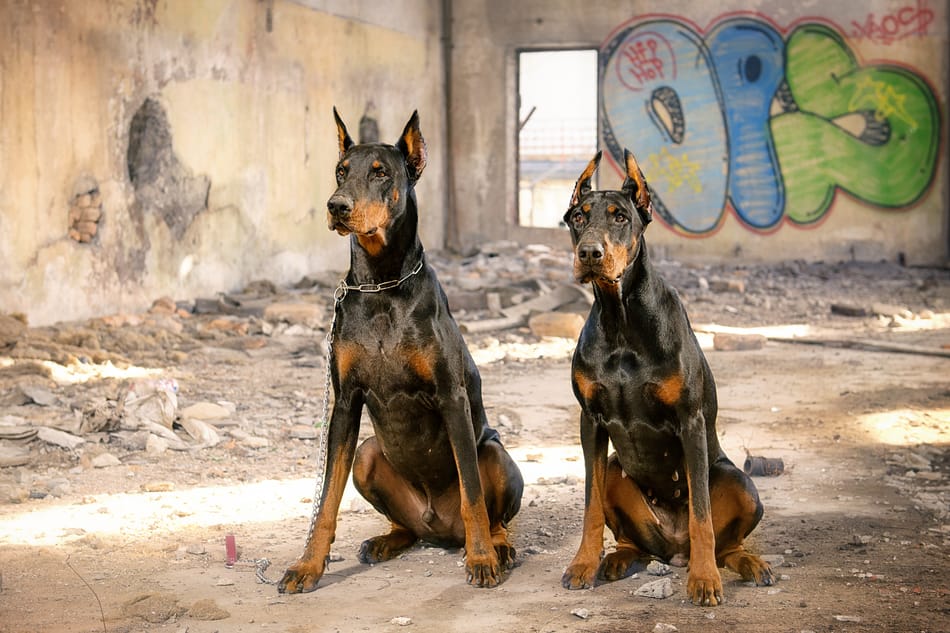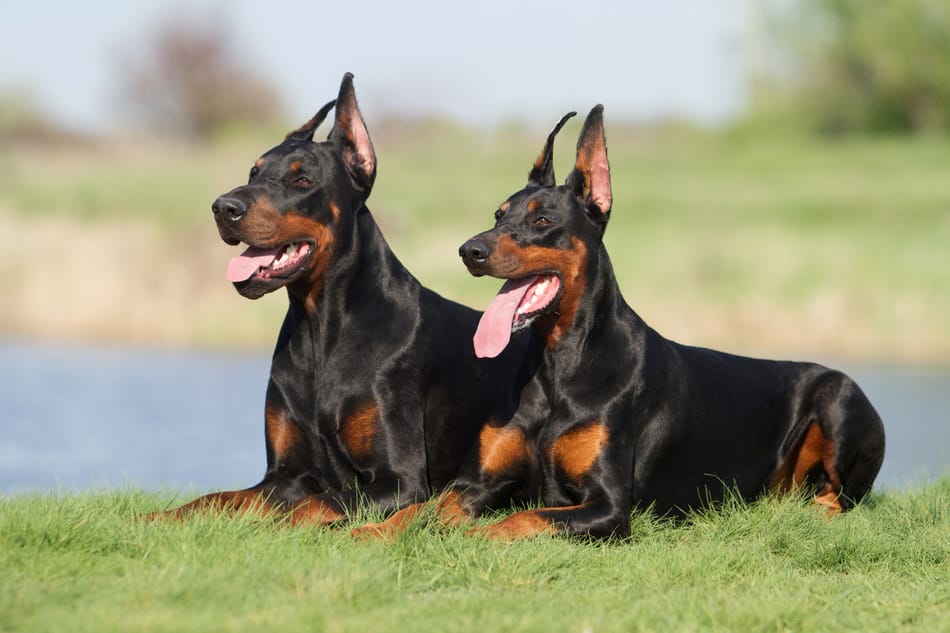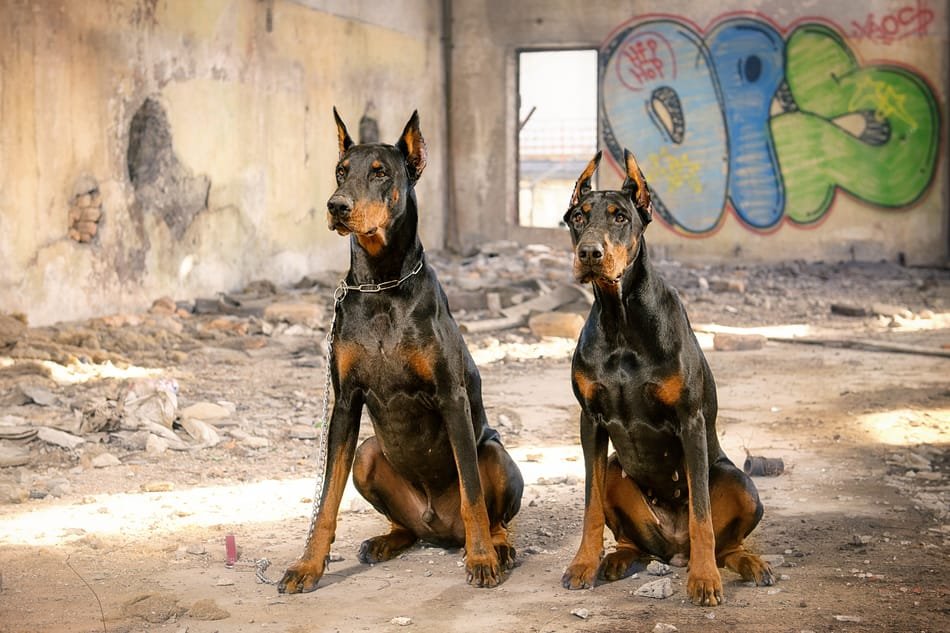When it comes to choosing the gender of a Doberman, it is a decision that dog owners often ponder. Perhaps you are wondering which gender would be the best fit for your lifestyle and preferences. Well, here’s an interesting fact: both male and female Dobermans have their own unique characteristics and qualities that can make them the ideal companion.
Doberman Pinschers have a rich history that dates back to the late 19th century. Originally bred in Germany by a tax collector named Louis Dobermann, these dogs were used for protection and as loyal guardians. Today, they are known for their intelligence, loyalty, and versatility. When it comes to choosing the best gender, it ultimately depends on your personal preferences and what you’re looking for in a Doberman. While male Dobermans tend to be larger in size and may be more aloof, female Dobermans are often more affectionate and easier to train. However, it’s important to note that individual personalities can vary, so it’s crucial to spend time with both genders before making a decision.
When it comes to choosing the best gender for a Doberman, it ultimately depends on your preferences and needs. Both male and female Dobermans can make excellent pets and companions. Males may be slightly larger and more dominant, while females tend to be more affectionate and protective. However, individual personalities can vary, so it’s essential to meet and interact with both genders before making a decision. Consider factors like temperament, energy level, and compatibility with your household to determine which gender suits your lifestyle best.

What Gender Doberman is Best?
A Doberman is a popular breed of dog known for its loyalty, intelligence, and protective nature. If you’re considering adding a Doberman to your family, you may be wondering which gender is best suited for your needs. While there are individual differences, understanding the general characteristics of male and female Dobermans can help you make an informed decision. In this article, we will explore the traits, advantages, and considerations of both male and female Dobermans to determine which gender may be the best fit for you.
Male Dobermans
Male Dobermans tend to have a larger and more muscular build compared to females. They typically weigh between 75 to 100 pounds and stand around 26 to 28 inches tall at the shoulder. Male Dobermans are known for their confident and assertive nature, making them excellent protectors and guard dogs. They are also generally more territorial and may be more inclined to mark their territory compared to females. However, with proper training and socialization, this behavior can be managed.
One advantage of owning a male Doberman is their imposing presence. Their size and appearance alone can act as a deterrent to potential intruders. Male Dobermans are often described as courageous and fearless, which makes them suitable for tasks that require physical strength and intimidation. However, it’s important to note that individual temperaments can vary, so not all male Dobermans will exhibit the same level of protective instincts.
When it comes to compatibility with other pets, male Dobermans may be more prone to dominance and territorial behavior, especially around other male dogs. Early socialization is crucial to ensure they learn to coexist peacefully with other animals. Male Dobermans are known to form strong bonds with their family members and can be loyal and affectionate companions.
Female Dobermans
Female Dobermans usually have a smaller and more elegant build compared to males. They typically weigh between 60 to 90 pounds and stand around 24 to 26 inches tall at the shoulder. Female Dobermans are known for their loyalty and protective instincts, making them excellent family dogs. They are often described as more sensitive and attentive to their surroundings compared to males.
One advantage of owning a female Doberman is their nurturing nature. Female Dobermans tend to be more maternal and affectionate, making them great companions for families with children. They are generally more tolerant of other pets and may have an easier time coexisting with other dogs, both male and female.
Female Dobermans are also often described as more trainable and responsive to commands. They tend to have a calmer demeanor and may adapt well to different environments. However, it’s important to note that female Dobermans may experience hormonal changes during their heat cycles, which can affect their behavior and require additional management.
Considerations When Choosing a Gender
When deciding which gender of Doberman is best for you, it’s important to consider your lifestyle, experience with dogs, and specific needs. Here are some key factors to keep in mind:
- Activity level: Male Dobermans generally have a higher energy level and may require more exercise and mental stimulation compared to females.
- Training: Female Dobermans are often perceived as easier to train due to their attentiveness and willingness to please. However, both genders are intelligent and can excel with proper training.
- Size and strength: Male Dobermans are typically larger and more muscular, which may be advantageous if you’re looking for a physically imposing dog.
- Compatibility with other pets: Female Dobermans may have an easier time getting along with other animals, but early socialization is essential for both genders.
- Heat cycles: Female Dobermans go through regular heat cycles, which can affect their behavior and require additional management.
| Male Dobermans | Female Dobermans |
|---|---|
| Confident and assertive | Loyal and attentive |
| Larger and more muscular build | Smaller and more elegant build |
| More territorial and prone to marking | Generally more tolerant of other pets |
| Potential dominance towards other male dogs | Easier time coexisting with other dogs |
Which Gender Doberman is Best for You?
Ultimately, the decision between a male or female Doberman depends on your specific preferences, lifestyle, and circumstances. Both genders have their unique characteristics and advantages. If you’re looking for a strong and imposing protector, a male Doberman may be a good choice. On the other hand, if you value loyalty, attentiveness, and compatibility with other pets, a female Doberman may be the better fit.
Regardless of the gender you choose, it’s important to prioritize proper training, socialization, and regular exercise to ensure a happy and well-adjusted Doberman. Consult with reputable breeders or rescue organizations to learn more about the individual personalities and temperaments of the Dobermans available for adoption. With careful consideration and preparation, you can find the perfect gender Doberman to join your family.
Key Takeaways: What Gender Doberman is Best?
- 1. The best gender of a Doberman depends on your personal preferences and needs.
- 2. Male Dobies are typically larger and more protective, making them suitable for security purposes.
- 3. Female Dobies are generally smaller and more affectionate, making them great companions.
- 4. Both genders can be trained equally well and can excel in various activities, such as agility or obedience.
- 5. It’s important to consider factors like temperament and individual personalities when choosing a Doberman’s gender.
Frequently Asked Questions
Here are some commonly asked questions about the best gender for Dobermans:
1. Which gender of Doberman is better for families?
Both male and female Dobermans can make great family pets. However, the best gender for a Doberman in a family setting depends on various factors, such as the dog’s individual temperament and the dynamics of the household. It’s important to consider the dog’s behavior, socialization, and training rather than solely basing the decision on their gender.
Male Dobermans may exhibit dominant behavior and can be slightly more territorial, while female Dobermans tend to be more nurturing and protective. Ultimately, the compatibility between the dog and the family should be the primary consideration when choosing the gender of a Doberman for a family.
2. Are male Dobermans more aggressive than females?
There is a common misconception that male Dobermans are more aggressive than females. However, aggression in Dobermans is not solely determined by gender. Aggression can be influenced by a variety of factors, including genetics, individual temperament, socialization, and training.
Some male Dobermans may exhibit more dominance, especially if they are not properly trained or socialized. On the other hand, female Dobermans can also display protective and assertive behavior. It’s important to focus on providing proper training and socialization to ensure a well-behaved and balanced Doberman, regardless of their gender.
3. Is it easier to train male or female Dobermans?
Generally, male and female Dobermans have similar capacities for learning and can be trained effectively with the right approach. The key to successful training is consistency, positive reinforcement, and understanding the individual dog’s needs and motivations.
Male Dobermans may have a slightly more independent streak, while females tend to be more attentive and eager to please. However, these traits are not exclusive to gender and can vary between individual dogs. It’s important to adapt the training methods to suit the specific dog’s personality rather than focusing solely on stereotypes associated with their gender.
4. Are female Dobermans more affectionate than males?
Affectionate behavior can vary among individual Dobermans, regardless of their gender. While some female Dobermans may display more nurturing behaviors, male Dobermans can also be loving and affectionate companions.
The level of affection shown by a Doberman is influenced by various factors, including their genetics, early socialization, and the quality of their bond with their owners. It’s crucial to build a strong and loving relationship with any Doberman, regardless of their gender, through positive interactions, training, and regular exercise.
5. Do male or female Dobermans have fewer health issues?
Both male and female Dobermans are prone to similar health issues, such as hip dysplasia, cardiomyopathy, or von Willebrand’s disease. The gender of a Doberman does not significantly affect their susceptibility to health problems.
It’s essential to prioritize regular veterinary care, a balanced diet, proper exercise, and routine health screenings for any Doberman, regardless of their gender. Early detection and proactive management can help maintain the overall health and well-being of a Doberman, regardless of their gender.

Male vs. Female Dobermans: How They Are Different
In choosing the best gender for a Doberman, there are a few considerations to keep in mind.
Firstly, it’s important to note that both male and female Dobermans can make excellent pets. However, there are a few differences to consider. Male Dobermans are generally larger and more muscular, which can make them better suited for activities like protection or working in certain fields, such as police or military work. On the other hand, female Dobermans are typically slightly smaller and may have a calmer temperament, making them great companions for families or individuals looking for a loving and loyal pet.
Ultimately, the best gender for a Doberman depends on your personal preferences and the specific traits you’re seeking in a pet. It’s important to spend time with both male and female Dobermans to see which gender aligns best with your lifestyle and needs. Whether you choose a male or female Doberman, providing proper training, care, and socialization will ensure a happy and well-adjusted pet.
